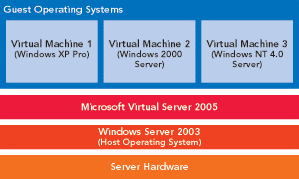Server Virtualization
Microsoft Virtual Server 2005- Overview and Features
Microsoft released its first server-based virtualization technology, Virtual Server, in September 2004. It was designed to create virtual machines on Windows XP, Windows Vista and Windows Server 2003. Microsoft Virtual Server is meant for running multiple VMs at enterprise level since it provides more security and more advanced networking features. Besides, it is compatible with 32 bit as well 64 bit host operating system and has an ability to run up to 64 virtual machines on a single host.

Virtual Server 2005 VHD
Virtual Server 2005 stores its virtual machine's data in a file called .VHD which resides on the physical disk. The two main VHD (virtual hard disk) that Virtualization with Microsoft Virtual Server 2005 supports are dynamically expanding and fixed size VHD. Dynamic VHD is created initially small then expands when data is written to it until it reaches the size limit whereas fixed size VHD is created with a fixed size and its size remains unchanged when data is added to it.
Features of Microsoft Virtual Server 2005
- Microsoft Virtual Server can support VHD up to 2048 GB size.
- This virtualization technology support SCSI hard disk, iSCSI network storage and clustering.
- Virtualization with Microsoft Virtual Server 2005 is achieved by running multiple VMs simultaneously due to its multi-threaded feature.
- Virtual Server 2005 R2 SP1 support Linux as Guest operating system.
- Virtual Server 2005 R2 SP1 provides Volume Shadow Copy writer service to backup Guest OS on Windows Server 2003 or 2008.
- Virtual Server cannot be installed on Windows 7 and Windows Server 2008 R2 or higher versions.
- Virtual Server does not support some multimedia drivers like sound driver.
Issues with Virtual Server 2005
Every so often, in Virtualization with Microsoft Virtual Server 2005, the main problem arises while mounting VHD or accessing VHDs' data, these issues are due to corrupt VHD or inaccessible data. In order to make corrupt VHD again accessible users tend to lose their valuable information. However, if Virtual Server 2005 VHD file got corrupt or some of your files and folders got deleted accidentally then the simplest way to recover data from damaged or healthy VHD is using VHD recovery software.